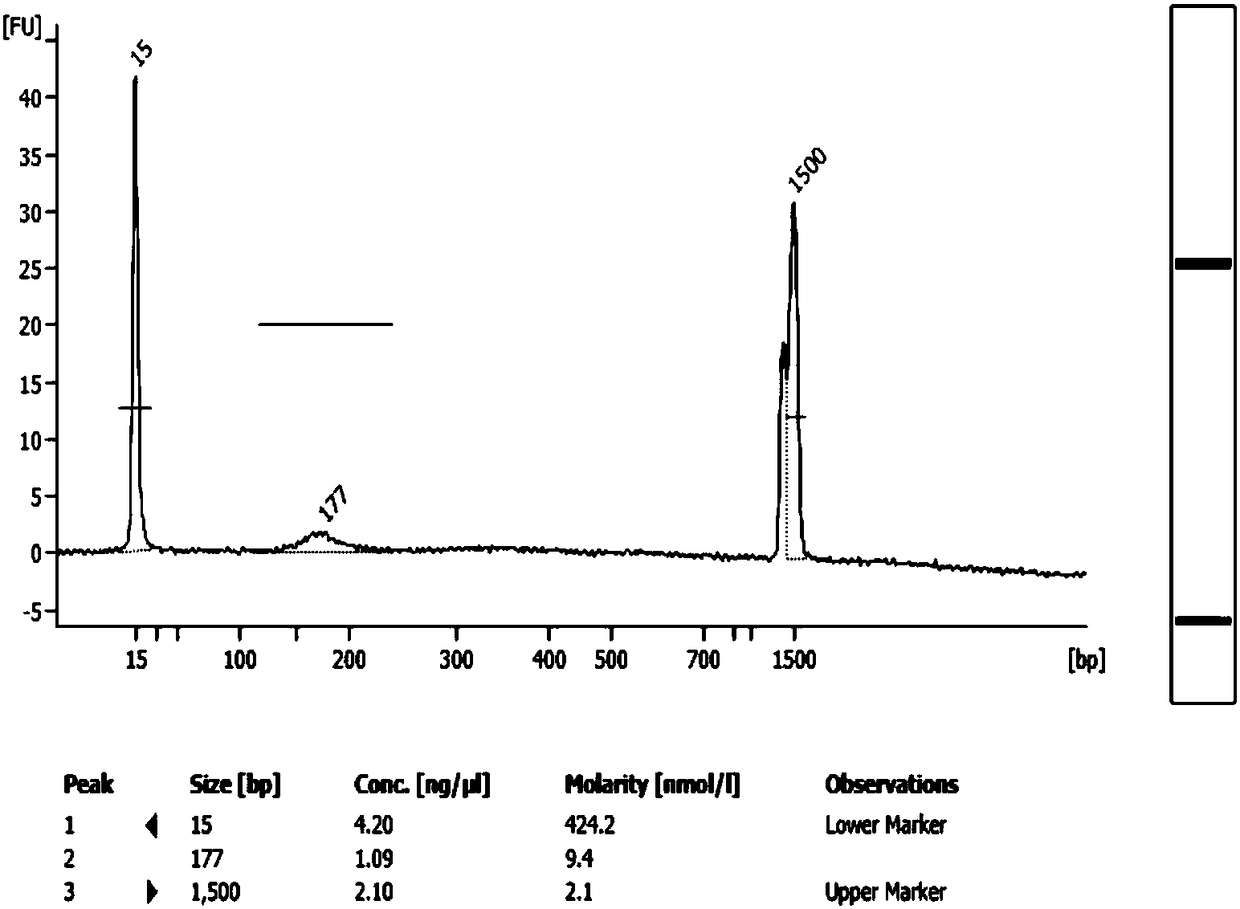Kit for DNA library building and application of kit
A technology of kits and DNA molecules, which is applied to kits for DNA library construction and its application fields, and can solve problems such as complex operations, long time-consuming, and low output of library construction
- Summary
- Abstract
- Description
- Claims
- Application Information
AI Technical Summary
Problems solved by technology
Method used
Image
Examples
Embodiment 1
[0061] Embodiment 1, the preparation of kit
[0062] The composition of 5×Fast Library Repair Mix 1 is shown in Table 1.
[0063] Table 1
[0064] components
[0065] For 10×T4PNK buffer and ddH 2 For O, the data in the second column of Table 1 is the amount added; for other components, the data in the second column of Table 1 is the concentration of the component in 5× Fast Library Repair Mix 1.
[0066] Wherein, dNTP is formed by mixing dATP, dCTP, dTTP, and dGTP in a ratio of 1:1:1:1. For example, a dNTP concentration of 1.25 nmol / μL means that the dATP, dCTP, dTTP and dGTP concentrations are all 1.25 nmol / μL.
[0067] The composition of Adaptor Ligation Mix 2 is shown in Table 2.
[0068] Table 2
[0069] components
[0070] For 10×T4PNK buffer, the data in the second column of Table 2 is the amount of the component added in the 30 μL system; for other components, the data in the second column of Table 2 is the amount of the component in the 30 μL ...
Embodiment 2
[0071] Embodiment 2, establishment of method
[0072] 1. Extract free nucleic acid from plasma (plasma comes from normal population or tumor patients)
[0073] 1. Take EDTA anticoagulated peripheral blood, centrifuge at 4°C and 1600g for 10 minutes, and collect the upper plasma.
[0074] 2. Take the plasma obtained in step 1, centrifuge at 12,000g at 4°C for 10 minutes, and collect the upper layer of plasma.
[0075] 3. Take the plasma obtained in step 2 and extract it with the QIAamp Circulating Nucleic Acid kit to obtain a free nucleic acid solution.
[0076] Take the free nucleic acid solution, using dsDNA BR Analysis Kit (Thermo Fisher Scientific, Cat. No. Q32850) was used to detect the concentration of dsDNA (the instrument was Agilent 2100 Bioanalyzer).
[0077] For the detection results of the free nucleic acid solution in a single test, see image 3 .
[0078] 2. Establishment of plasma cfDNA library
[0079] 1. Take the free nucleic acid solution obtained in s...
Embodiment 3
[0145] Application of the kit prepared in embodiment 3, embodiment 1 and the method established in embodiment 2
[0146] The EDTA anticoagulated peripheral blood of volunteers (normal population or tumor patients) with informed consent was collected, and the kit prepared in Example 1 was used for detection according to the method established in Example 2 (X=0.5).
[0147] 1. Different T4PNK concentrations were used in the end repair and A addition reactions
[0148] In the initial reaction system of end repair and A addition reaction, the concentration of T4PNK is 0.2U / μL, 0.4U / μL or 0.6U / μL, the concentration of Klenow Fragment is 0.6U / μL, and the concentration of LA Taq DNA Polymerase is 0.05U / μL, the concentration of T4DNAPolymerase is 0.12U / μL, the concentration of dNTP is 0.25nmol / μL, and the concentration of dATP is 0.2nmol / μL.
[0149] In the initial reaction system for adapter connection, each component adopts the best reference value.
[0150] The results are shown...
PUM
 Login to View More
Login to View More Abstract
Description
Claims
Application Information
 Login to View More
Login to View More - R&D
- Intellectual Property
- Life Sciences
- Materials
- Tech Scout
- Unparalleled Data Quality
- Higher Quality Content
- 60% Fewer Hallucinations
Browse by: Latest US Patents, China's latest patents, Technical Efficacy Thesaurus, Application Domain, Technology Topic, Popular Technical Reports.
© 2025 PatSnap. All rights reserved.Legal|Privacy policy|Modern Slavery Act Transparency Statement|Sitemap|About US| Contact US: help@patsnap.com



